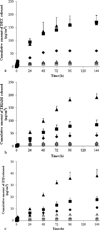Influence of drug lipophilicity on drug release from sclera after iontophoretic delivery of mixed micellar carrier system to human sclera
- PMID: 23150488
- PMCID: PMC3815607
- DOI: 10.1002/jps.23370
Influence of drug lipophilicity on drug release from sclera after iontophoretic delivery of mixed micellar carrier system to human sclera
Abstract
Mixed micelles prepared using sodium taurocholate (TA) and egg lecithin (LE) were previously found to be an effective carrier for sustained release of a poorly water-soluble drug in transscleral iontophoretic delivery. The objectives of the present study were to investigate the effects of drug lipophilicity upon micellar carrier solubilization potential and drug release profiles from the sclera after iontophoretic delivery of model lipophilic drugs dexamethasone (DEX), triamcinolone acetonide (TRIAM), and β-estradiol (E2β) with a mixed micellar carrier system of TA-LE (1:1 mole ratio). In this study, the micellar carrier system was characterized for drug solubilization. The micelles encapsulating these drugs were evaluated for transscleral passive and 2-mA iontophoretic delivery (both cathodal and anodal) and drug release from excised human sclera in vitro. The results show that drug solubility enhancement of the micellar carrier system increased with increasing drug lipophilicity. The more lipophilic drugs E2β and TRIAM displayed slower drug release from the sclera compared with the less lipophilic drug DEX after iontophoretic drug delivery with the mixed micelles. These results suggest that the combination of transscleral iontophoresis and micellar carriers is more effective in sustaining transscleral delivery of the more lipophilic drugs studied in this investigation.
Copyright © 2012 Wiley Periodicals, Inc.
Figures



Similar articles
-
Sustained release micellar carrier systems for iontophoretic transport of dexamethasone across human sclera.J Control Release. 2012 May 30;160(1):96-104. doi: 10.1016/j.jconrel.2012.01.032. Epub 2012 Jan 27. J Control Release. 2012. PMID: 22306336 Free PMC article.
-
Examination of penetration routes and distribution of ionic permeants during and after transscleral iontophoresis with magnetic resonance imaging.Int J Pharm. 2007 Apr 20;335(1-2):46-53. doi: 10.1016/j.ijpharm.2006.11.001. Epub 2006 Nov 3. Int J Pharm. 2007. PMID: 17236728 Free PMC article.
-
In vitro permeability of a model protein across ocular tissues and effect of iontophoresis on the transscleral delivery.Eur J Pharm Biopharm. 2014 Sep;88(1):116-22. doi: 10.1016/j.ejpb.2014.04.018. Epub 2014 May 9. Eur J Pharm Biopharm. 2014. PMID: 24816128
-
Transscleral passive and iontophoretic transport: theory and analysis.Expert Opin Drug Deliv. 2018 Mar;15(3):283-299. doi: 10.1080/17425247.2018.1406918. Epub 2017 Dec 5. Expert Opin Drug Deliv. 2018. PMID: 29149574 Review.
-
Basic principles and current status of transcorneal and transscleral iontophoresis.Expert Opin Drug Deliv. 2017 Sep;14(9):1091-1102. doi: 10.1080/17425247.2017.1266334. Epub 2016 Dec 11. Expert Opin Drug Deliv. 2017. PMID: 27892757 Review.
Cited by
-
Polymeric micelles for ocular drug delivery: From structural frameworks to recent preclinical studies.J Control Release. 2017 Feb 28;248:96-116. doi: 10.1016/j.jconrel.2017.01.012. Epub 2017 Jan 11. J Control Release. 2017. PMID: 28087407 Free PMC article. Review.
-
Prodrug-based nanomedicines for rheumatoid arthritis.Discov Nano. 2024 Jan 5;19(1):9. doi: 10.1186/s11671-023-03950-1. Discov Nano. 2024. PMID: 38180534 Free PMC article. Review.
-
Resveratrol Brain Delivery for Neurological Disorders Prevention and Treatment.Front Pharmacol. 2018 Nov 20;9:1261. doi: 10.3389/fphar.2018.01261. eCollection 2018. Front Pharmacol. 2018. PMID: 30524273 Free PMC article. Review.
References
-
- Worakul N, Robinson JR. Ocular pharmacokinetics/pharmacodynamics. Eur J Pharm Biopharm. 1997;44(1):71–83.
-
- Maurice DM. Drug delivery to the posterior segment from drops. Surv Ophthalmol. 2002;47:S41–S52. - PubMed
-
- Geroski DH, Edelhauser HF. Drug delivery for posterior segment eye disease. Invest Ophthalmol Vis Sci. 2000;41(5):961–964. - PubMed
-
- Lee SS, Hughes PM, Robinson MR. Recent advances in drug delivery systems for treating ocular complications of systemic diseases. Curr Opin Ophthalmol. 2009;20(6):511–519. - PubMed
-
- Meyer CH, Krohne TU, Holz FG. Intraocular pharmacokinetics after a single intravitreal injection of 1.5 mg versus 3.0 mg of bevacizumab in humans. Retina. 2011;31(9):1877–1884. - PubMed
Publication types
MeSH terms
Substances
Grants and funding
LinkOut - more resources
Full Text Sources
Other Literature Sources

